2009 NISSAN LATIO air condition
[x] Cancel search: air conditionPage 3361 of 4331
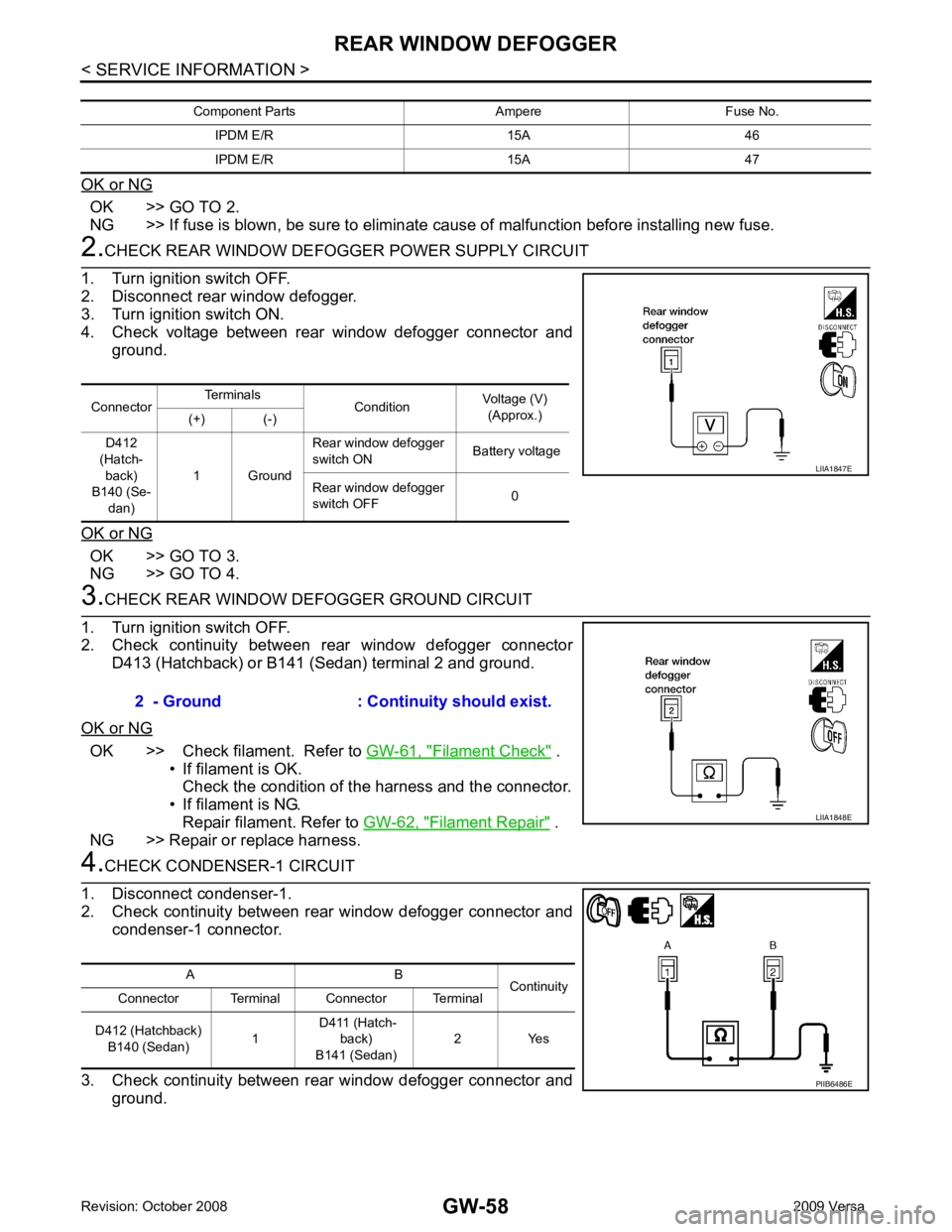
OK >> GO TO 2.
NG >> If fuse is blown, be sure to eliminate cause of malfunction before installing new fuse. OK >> GO TO 3.
NG >> GO TO 4. OK >> Check filament. Refer to
GW-61, " Filament Check " .
• If filament is OK.
Check the condition of the harness and the connector.
• If filament is NG. Repair filament. Refer to GW-62, " Filament Repair " .
NG >> Repair or replace harness. Connector
Terminals
ConditionVoltage (V)
(Approx.)
(+) (-)
D412
(Hatch- back)
B140 (Se-
dan) 1 Ground Rear window defogger
switch ON Battery voltage
Rear window defogger
switch OFF 0
Page 3363 of 4331
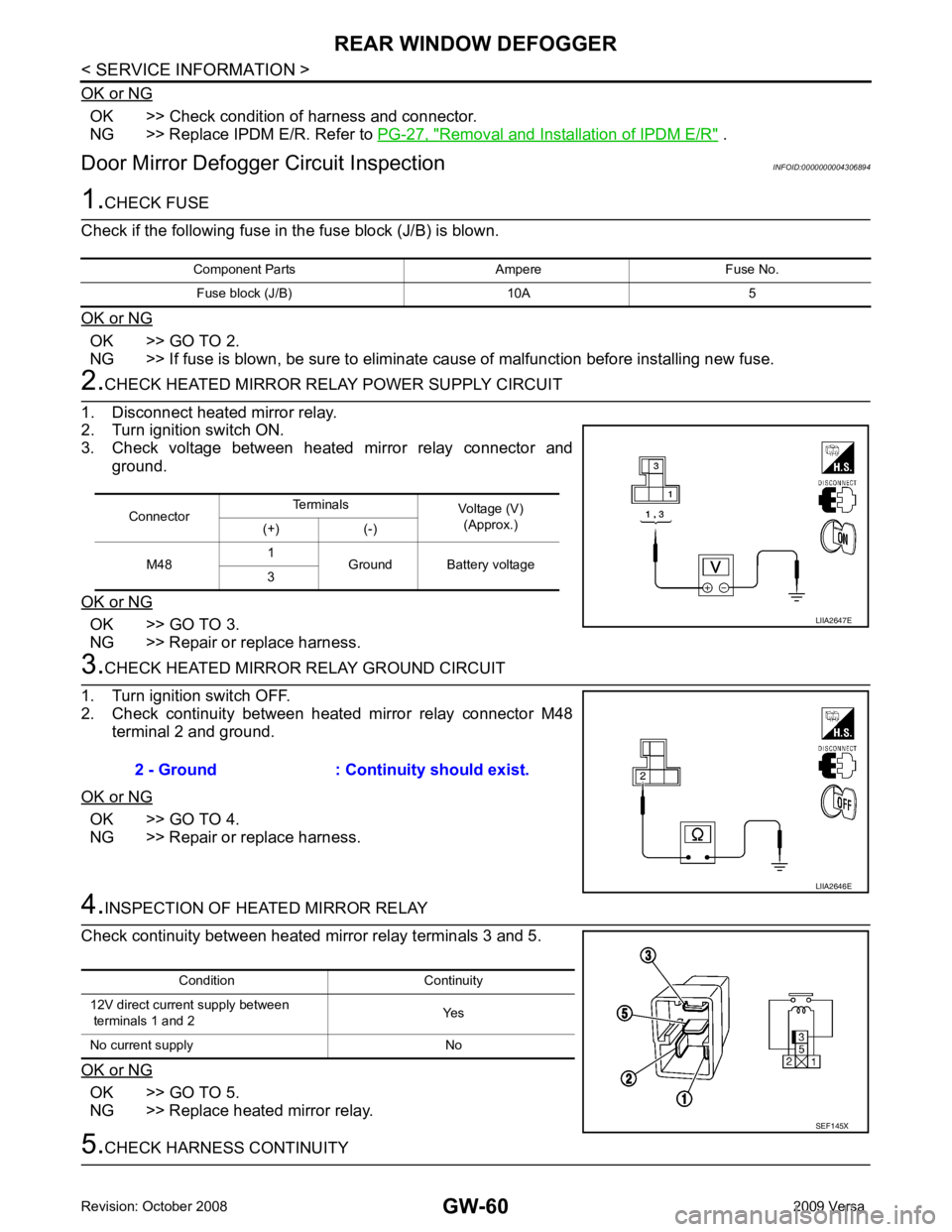
OK >> Check condition of harness and connector.
NG >> Replace IPDM E/R. Refer to PG-27, " Removal and Installation of IPDM E/R " .
Door Mirror Defogger Circuit Inspection INFOID:0000000004306894OK >> GO TO 2.
NG >> If fuse is blown, be sure to eliminate cause of malfunction before installing new fuse. OK >> GO TO 3.
NG >> Repair or replace harness. OK >> GO TO 4.
NG >> Repair or replace harness. OK >> GO TO 5.
NG >> Replace heated mirror relay. Connector
Terminals
Voltage (V)
(Approx.)
(+) (-)
M48 1
Ground Battery voltage
3
Page 3375 of 4331
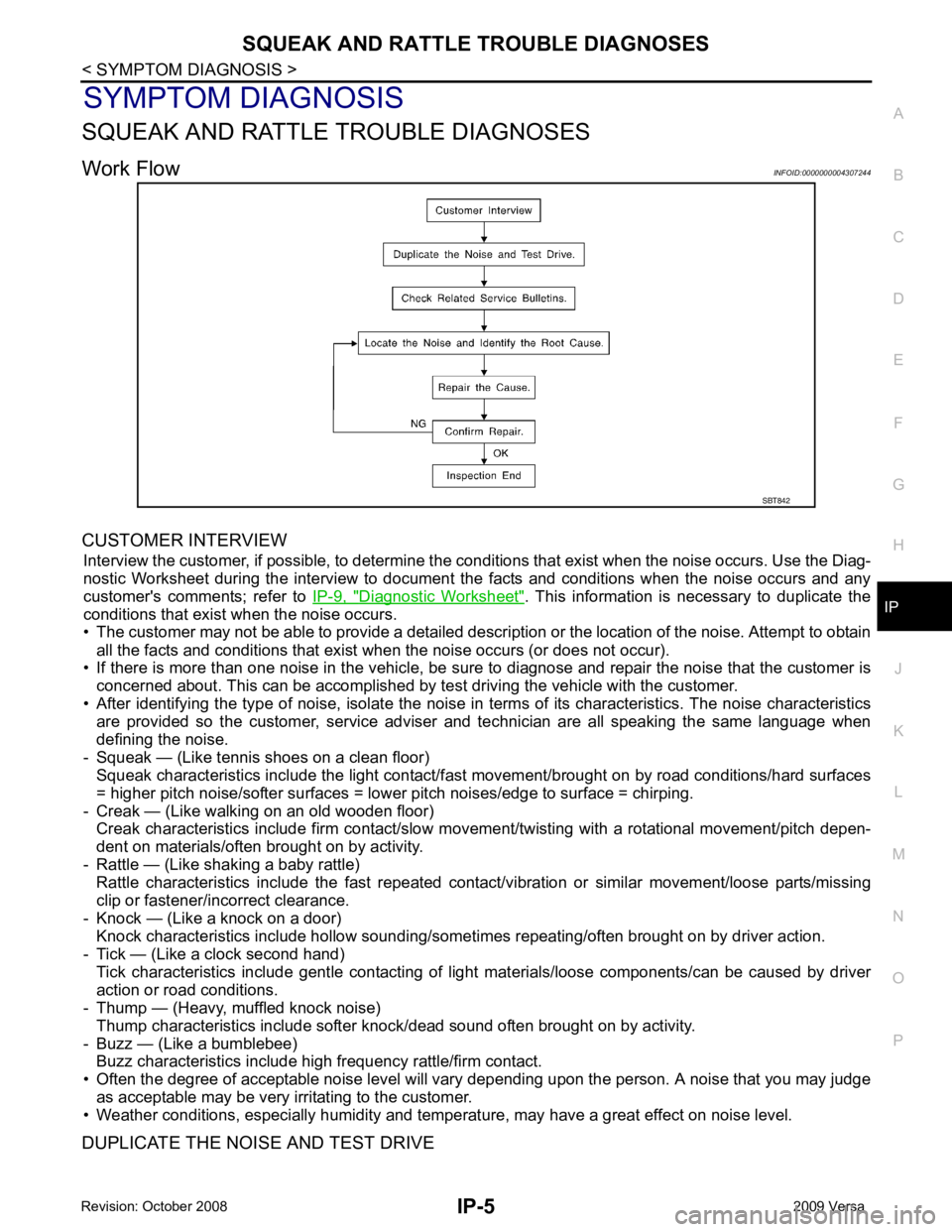
SQUEAK AND RATTLE TROUBLE DIAGNOSES
IP-5
< SYMPTOM DIAGNOSIS >
C
D E
F
G H
J
K L
M A
B IP
N
O P
SYMPTOM DIAGNOSIS
SQUEAK AND RATTLE TROUBLE DIAGNOSES
Work Flow INFOID:0000000004307244
CUSTOMER INTERVIEW Interview the customer, if possible, to determine the c onditions that exist when the noise occurs. Use the Diag-
nostic Worksheet during the interv iew to document the facts and conditions when the noise occurs and any
customer's comments; refer to IP-9, " Diagnostic Worksheet " . This information is necessary to duplicate the
conditions that exist when the noise occurs.
• The customer may not be able to provide a detailed descr iption or the location of the noise. Attempt to obtain
all the facts and conditions that exist when the noise occurs (or does not occur).
• If there is more than one noise in the vehicle, be sure to diagnose and repair the noise that the customer is
concerned about. This can be accomplished by te st driving the vehicle with the customer.
• After identifying the type of noise, isolate the noise in terms of its characteristics. The noise characteristics
are provided so the customer, service adviser and technician are all speaking the same language when
defining the noise.
- Squeak — (Like tennis shoes on a clean floor) Squeak characteristics include the light contact/fast movement/brought on by road conditions/hard surfaces
= higher pitch noise/softer surfaces = lower pitch noises/edge to surface = chirping.
- Creak — (Like walking on an old wooden floor) Creak characteristics include firm contact/slow mo vement/twisting with a rotational movement/pitch depen-
dent on materials/often brought on by activity.
- Rattle — (Like shaking a baby rattle) Rattle characteristics include the fast repeated contac t/vibration or similar movement/loose parts/missing
clip or fastener/incorrect clearance.
- Knock — (Like a knock on a door) Knock characteristics include hollow sounding/someti mes repeating/often brought on by driver action.
- Tick — (Like a clock second hand) Tick characteristics include gentle contacting of li ght materials/loose components/can be caused by driver
action or road conditions.
- Thump — (Heavy, muffled knock noise)
Thump characteristics include softer k nock/dead sound often brought on by activity.
- Buzz — (Like a bumblebee) Buzz characteristics include high frequency rattle/firm contact.
• Often the degree of acceptable noise level will vary depending upon the person. A noise that you may judge
as acceptable may be very irritating to the customer.
• Weather conditions, especially humidity and temperature, may have a great effect on noise level.
DUPLICATE THE NOISE AND TEST DRIVE SBT842
Page 3377 of 4331
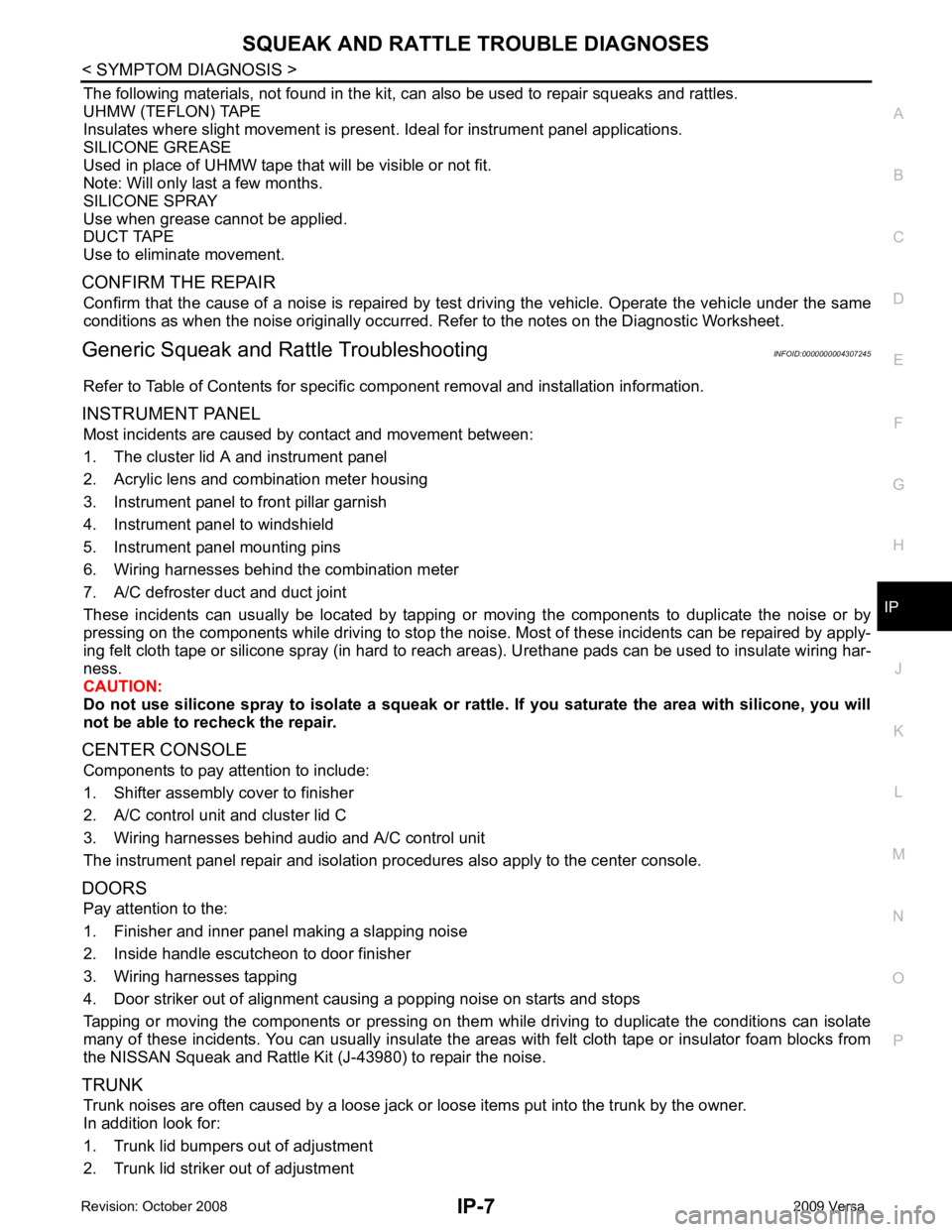
IP
N
O P
The following materials, not found in the kit, can also be used to repair squeaks and rattles.
UHMW (TEFLON) TAPE
Insulates where slight movement is present. Ideal for instrument panel applications.
SILICONE GREASE
Used in place of UHMW tape that will be visible or not fit.
Note: Will only last a few months.
SILICONE SPRAY
Use when grease cannot be applied.
DUCT TAPE
Use to eliminate movement.
CONFIRM THE REPAIR Confirm that the cause of a noise is repaired by test driving the vehicle. Operate the vehicle under the same
conditions as when the noise originally occurred. Refer to the notes on the Diagnostic Worksheet.
Generic Squeak and Rattle Troubleshooting INFOID:0000000004307245
Refer to Table of Contents for specific component removal and installation information.
INSTRUMENT PANEL Most incidents are caused by contact and movement between:
1. The cluster lid A and instrument panel
2. Acrylic lens and combination meter housing
3. Instrument panel to front pillar garnish
4. Instrument panel to windshield
5. Instrument panel mounting pins
6. Wiring harnesses behind the combination meter
7. A/C defroster duct and duct joint
These incidents can usually be located by tapping or moving the components to duplicate the noise or by
pressing on the components while driving to stop the noi se. Most of these incidents can be repaired by apply-
ing felt cloth tape or silicone spray (in hard to reach areas). Urethane pads can be used to insulate wiring har-
ness.
CAUTION:
Do not use silicone spray to isolate a squeak or ra ttle. If you saturate the area with silicone, you will
not be able to recheck the repair.
CENTER CONSOLE Components to pay attention to include:
1. Shifter assembly cover to finisher
2. A/C control unit and cluster lid C
3. Wiring harnesses behind audio and A/C control unit
The instrument panel repair and isolation pr ocedures also apply to the center console.
DOORS Pay attention to the:
1. Finisher and inner panel making a slapping noise
2. Inside handle escutcheon to door finisher
3. Wiring harnesses tapping
4. Door striker out of alignment causing a popping noise on starts and stops
Tapping or moving the components or pressing on them wh ile driving to duplicate the conditions can isolate
many of these incidents. You can usually insulate the ar eas with felt cloth tape or insulator foam blocks from
the NISSAN Squeak and Rattle Kit (J-43980) to repair the noise.
TRUNK Trunk noises are often caused by a loose jack or loose items put into the trunk by the owner.
In addition look for:
1. Trunk lid bumpers out of adjustment
2. Trunk lid striker out of adjustment
Page 3396 of 4331
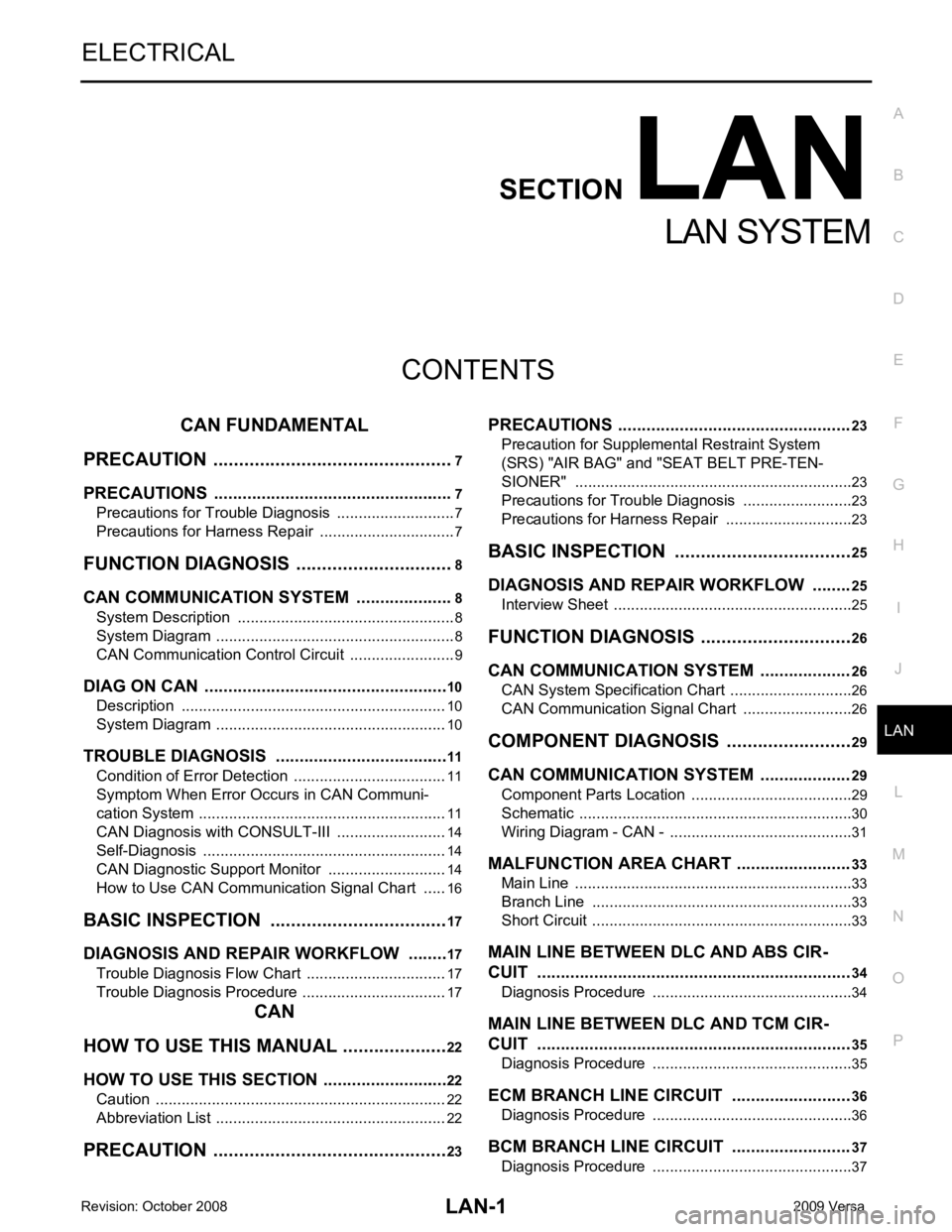
LAN
N
O P
CONTENTS
LAN SYSTEM
CAN FUNDAMENTAL
PRECAUTION ....... ........................................
7
PRECAUTIONS .............................................. .....7
Precautions for Trouble Diagnosis ...................... ......7
Precautions for Harness Repair ................................7
FUNCTION DIAGNOSIS .. .............................8
CAN COMMUNICATION SYSTEM ................ .....8
System Description ............................................. ......8
System Diagram .................................................. ......8
CAN Communication Control Circuit ................... ......9
DIAG ON CAN ................................................ ....10
Description .......................................................... ....10
System Diagram .................................................. ....10
TROUBLE DIAGNOSIS ................................. ....11
Condition of Error Detection ................................ ....11
Symptom When Error Oc curs in CAN Communi-
cation System ...................................................... ....
11
CAN Diagnosis with CONSULT-III ...................... ....14
Self-Diagnosis ..................................................... ....14
CAN Diagnostic Support Monitor ........................ ....14
How to Use CAN Communication Signal Chart .. ....16
BASIC INSPECTION ....... ............................17
DIAGNOSIS AND REPAIR WORKFLOW ..... ....17
Trouble Diagnosis Flow Chart ............................. ....17
Trouble Diagnosis Procedure .............................. ....17
CAN
HOW TO USE THIS MANU AL .....................22
HOW TO USE THIS SECTION ....................... ....22
Caution ................................................................ ....22
Abbreviation List .................................................. ....22
PRECAUTION ....... .......................................23 PRECAUTIONS .................................................
23
Precaution for Supplemental Restraint System
(SRS) "AIR BAG" and "SEAT BELT PRE-TEN-
SIONER" ............................................................. ....
23
Precautions for Trouble Diagnosis ...................... ....23
Precautions for Harness Repair .......................... ....23
BASIC INSPECTION ....... ............................25
DIAGNOSIS AND REPAIR WORKFLOW ........ 25
Interview Sheet .................................................... ....25
FUNCTION DIAGNOSIS .. ............................26
CAN COMMUNICATION SYSTEM ................... 26
CAN System Specification Chart ......................... ....26
CAN Communication Signal Chart ...................... ....26
COMPONENT DIAGNOSIS .........................29
CAN COMMUNICATION SYSTEM ................... 29
Component Parts Location .................................. ....29
Schematic ............................................................ ....30
Wiring Diagram - CAN - ....................................... ....31
MALFUNCTION AREA CHART ........................ 33
Main Line ............................................................. ....33
Branch Line ......................................................... ....33
Short Circuit ......................................................... ....33
MAIN LINE BETWEEN DLC AND ABS CIR-
CUIT .................................................................. 34
Diagnosis Procedure ........................................... ....34
MAIN LINE BETWEEN DLC AND TCM CIR-
CUIT .................................................................. 35
Diagnosis Procedure ........................................... ....35
ECM BRANCH LINE CIRCUIT ......................... 36
Diagnosis Procedure ........................................... ....36
BCM BRANCH LINE CIRCUIT ......................... 37
Diagnosis Procedure ........................................... ....37
Page 3412 of 4331
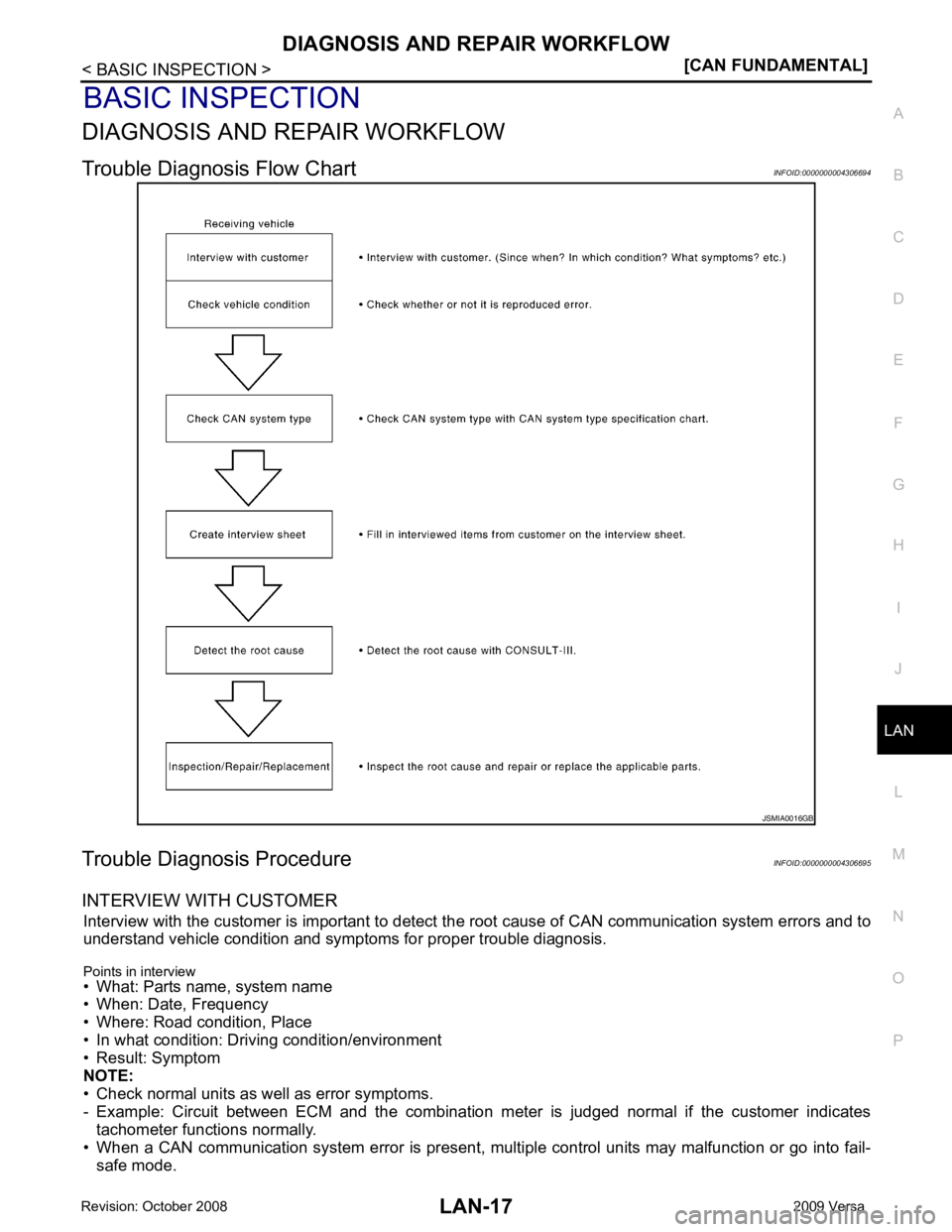
LAN
N
O P
BASIC INSPECTION
DIAGNOSIS AND REPAIR WORKFLOW
Trouble Diagnosis Flow Chart INFOID:0000000004306694
Trouble Diagnosis Procedure INFOID:0000000004306695
INTERVIEW WITH CUSTOMER Interview with the customer is important to detect t he root cause of CAN communication system errors and to
understand vehicle condition and symptoms for proper trouble diagnosis.
Points in interview
• What: Parts name, system name
• When: Date, Frequency
• Where: Road condition, Place
• In what condition: Driving condition/environment
• Result: Symptom
NOTE:
• Check normal units as well as error symptoms.
- Example: Circuit between ECM and the combination meter is judged normal if the customer indicates tachometer functions normally.
• When a CAN communication system error is present, mult iple control units may malfunction or go into fail-
safe mode.
Page 3622 of 4331
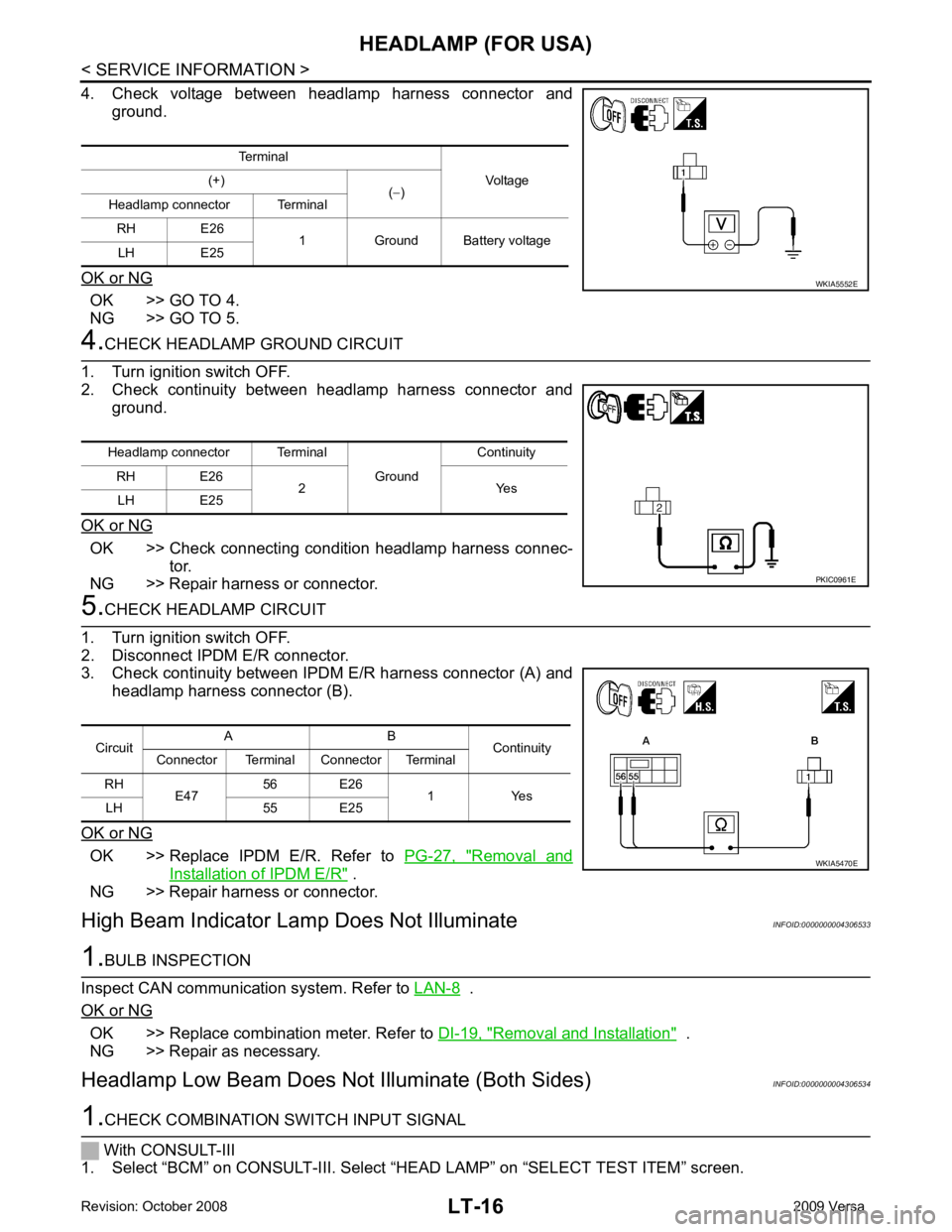
LT-16< SERVICE INFORMATION >
HEADLAMP (FOR USA)
4. Check voltage between headlamp harness connector and ground.
OK or NG OK >> GO TO 4.
NG >> GO TO 5. 4.
CHECK HEADLAMP GROUND CIRCUIT
1. Turn ignition switch OFF.
2. Check continuity between headlamp harness connector and ground.
OK or NG OK >> Check connecting condition headlamp harness connec-
tor.
NG >> Repair harness or connector. 5.
CHECK HEADLAMP CIRCUIT
1. Turn ignition switch OFF.
2. Disconnect IPDM E/R connector.
3. Check continuity between IPDM E/R harness connector (A) and
headlamp harness connector (B).
OK or NG OK >> Replace IPDM E/R. Refer to
PG-27, " Removal and
Installation of IPDM E/R " .
NG >> Repair harness or connector.
High Beam Indicator Lam p Does Not Illuminate INFOID:00000000043065331.
BULB INSPECTION
Inspect CAN communication system. Refer to LAN-8 .
OK or NG OK >> Replace combination meter. Refer to
DI-19, " Removal and Installation " .
NG >> Repair as necessary.
Headlamp Low Beam Does Not Illuminate (Both Sides) INFOID:00000000043065341.
CHECK COMBINATION SWITCH INPUT SIGNAL
With CONSULT-III
1. Select “BCM” on CONSULT-III. Select “HEAD LAMP” on “SELECT TEST ITEM” screen.
Terminal
Voltage
(+)
(− )
Headlamp connector Terminal
RH E26 1 Ground Battery voltage
LH E25 WKIA5552E
Headlamp connector Terminal
Ground Continuity
RH E26 2 Yes
LH E25 PKIC0961E
Circuit
A B
Continuity
Connector Terminal Connector Terminal
RH E47 56 E26
1 Yes
LH 55 E25 WKIA5470E
Page 3625 of 4331
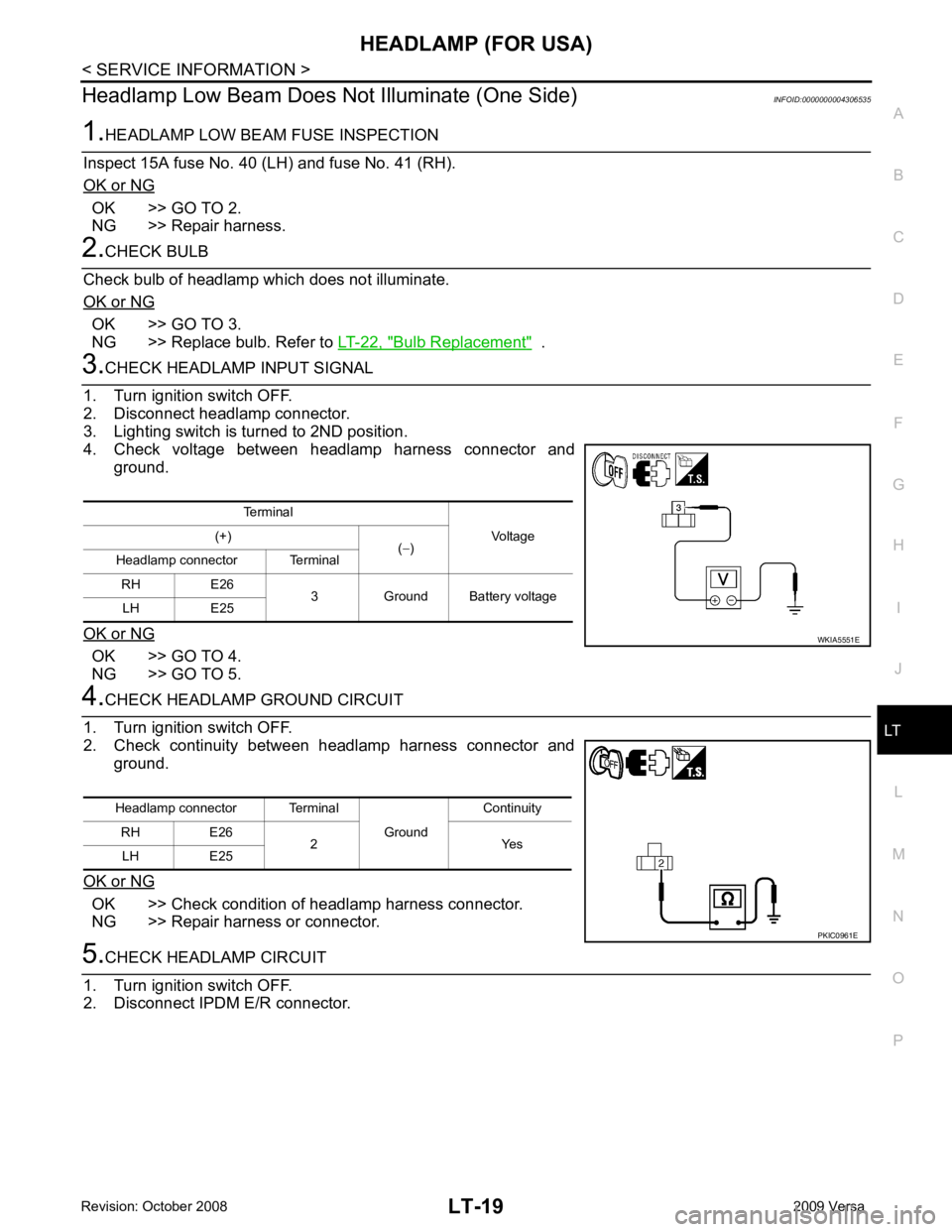
LT
N
O P
Headlamp Low Beam Does
Not Illuminate (One Side) INFOID:0000000004306535OK >> GO TO 2.
NG >> Repair harness. OK >> GO TO 3.
NG >> Replace bulb. Refer to LT-22, " Bulb Replacement " .
OK >> GO TO 4.
NG >> GO TO 5. OK >> Check condition of headlamp harness connector.
NG >> Repair harness or connector.